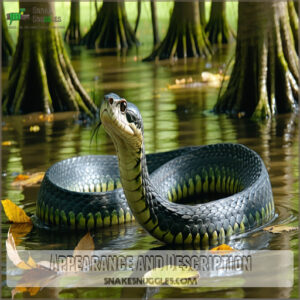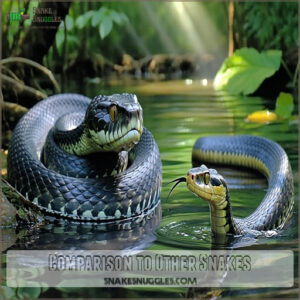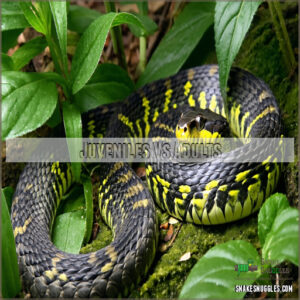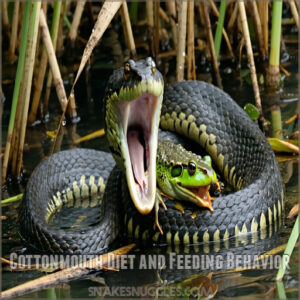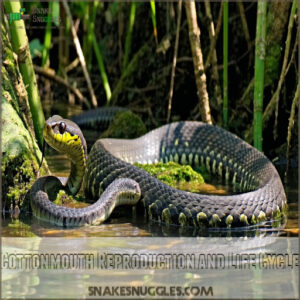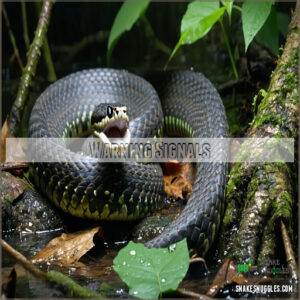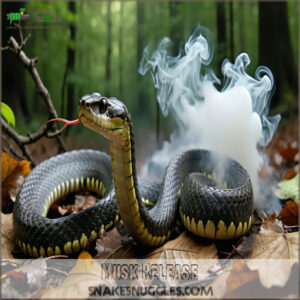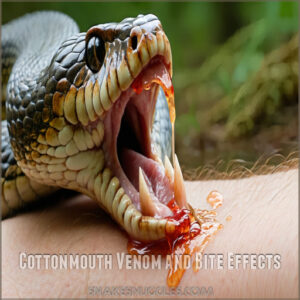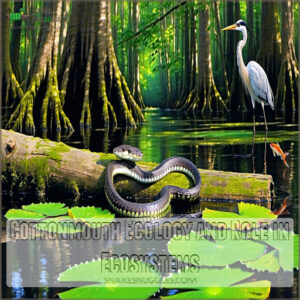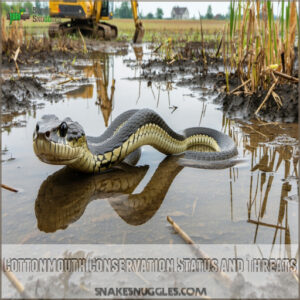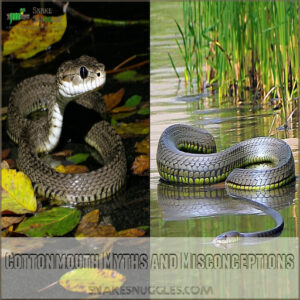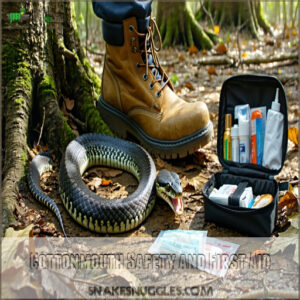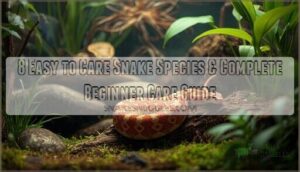This site is supported by our readers. We may earn a commission, at no cost to you, if you purchase through links.
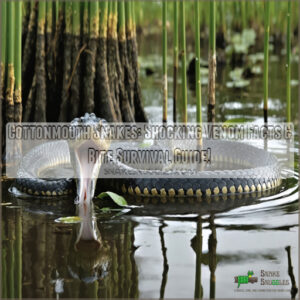
They’re named for the bright white lining of their mouths, which they flash as a warning—kind of like nature’s “back off” sign.
These stout, muscular snakes thrive in the wetlands of the southeastern U.S. and are excellent swimmers.
Juveniles sport flashy yellow tails, while adults can grow up to 6 feet long.
Their venom isn’t just painful—it can cause serious tissue damage, so don’t mess with one!
If bitten, stay calm, avoid moving too much, and seek medical help immediately.
Curious about their role in ecosystems? There’s more to uncover!
Table Of Contents
- Key Takeaways
- Cottonmouth Identification
- Cottonmouth Habitat and Range
- Cottonmouth Diet and Feeding Behavior
- Cottonmouth Reproduction and Life Cycle
- Cottonmouth Defensive Behaviors
- Cottonmouth Venom and Bite Effects
- Cottonmouth Ecology and Role in Ecosystems
- Cottonmouth Conservation Status and Threats
- Cottonmouth Myths and Misconceptions
- Cottonmouth Safety and First Aid
- Frequently Asked Questions (FAQs)
- What are some interesting facts about cottonmouths?
- How serious is a cottonmouth bite?
- Can you survive a cottonmouth bite without treatment?
- What are the odds of surviving a cottonmouth bite?
- What does a cottonmouth bite do?
- Can a human survive a cottonmouth bite?
- Are cottonmouths aggressive?
- How long can cottonmouths live in captivity?
- What predators hunt and eat cottonmouth snakes?
- Can cottonmouths climb trees or swim underwater?
- Conclusion
Key Takeaways
I’ll help you extract the key takeaways about cottonmouth snakes while following the specified guidelines.
- You’ll want to stay calm if you encounter a cottonmouth snake – they’re not looking to attack you. These venomous serpents prefer to warn you with their signature white mouth display and would rather escape than fight.
- A cottonmouth’s bite is serious business, but it’s survivable with quick medical intervention. Their venom can cause tissue damage and intense pain, but prompt antivenom treatment dramatically improves your chances of recovery.
- These snakes are ecological superstars, playing a crucial role in wetland ecosystems. They help control populations of small animals and serve as important biodiversity indicators, proving that even venomous creatures have significant environmental value.
- You can identify a cottonmouth by its distinctive features: a blocky head, thick body, dark coloration, and vertical pupils. Juveniles are especially recognizable with their bright yellow-green tails and dramatic black and yellow crossbands.
Cottonmouth Identification
When you’re out in the wild, spotting a cottonmouth snake can be tricky, but knowing its key features can save your life.
With their stout, muscular bodies, dark brown or black scales, and that signature white mouth lining they flash when threatened, these venomous pit vipers are master camouflage artists you’ll want to recognize before getting too close.
Appearance and Description
Ever wonder what lurks in those murky southern waters?
The cottonmouth snake packs a punch with its muscular, 6-foot body draped in dark olive or black bands.
Its signature blocky head and thick neck scream "danger," while those vertical pupils hint at its predatory nature.
These snakes possess potent cottonmouth venom toxicity, and that white mouth lining is a warning sign.
It’s your final warning before this fierce hunter strikes.
Comparison to Other Snakes
Diving into the domain of water snakes reveals just how unique cottonmouths really are.
These venomous pit vipers stand out from their non-venomous cousins with distinctive features that scream "hands off!" One key difference lies in their heat-sensing pits, as detailed on this cottonmouth comparison page.
- Blocky heads vs. slender water snake profiles
- Elliptical cat-like pupils instead of round ones
- Distinct white mouth lining when threatened
- Thicker, more muscular body build
- Ridged scales with jagged, pixelated patterns
Their snake size variations and venom potency make them the ultimate water snake predators.
Juveniles Vs Adults
A young cottonmouth’s journey from baby to beast is a wild transformation.
These pint-sized predators start small but pack a serious punch.
- Their yellow-green tails scream "baby snake on patrol!"
- Dramatic black and yellow crossbands make them look like nature’s rebellious teenagers
- Each growth stage reveals new survival superpowers
- Watch them morph from vibrant youngsters to stealthy adult hunters
From 12 inches to 6 feet, these serpents prove size isn’t everything – their venom is always dangerous.
Cottonmouth Habitat and Range
If you’re exploring the southeastern United States and find yourself near a swampy creek or marshy pond, you’ve just entered prime cottonmouth territory.
These water-loving serpents aren’t just swimming enthusiasts—they’re masters of their wet, wild habitat, basking on logs and lurking in vegetation from Virginia to Texas, which makes them a key part of the southeastern ecosystem.
Aquatic Environments
After pinpointing those triangular heads in your last snake ID lesson, let’s explore where these water moccasins really thrive.
Cottonmouths rule river ecosystems and wetland habitats, swimming like scaly submarines through murky waters.
They’re master aquatic predators, gliding through swamps and marshes, hunting fish and frogs with deadly precision.
Water quality and aquatic plants set the stage for their watery kingdom.
Southeastern United States
Nearly every snake enthusiast knows cottonmouths rule the southeastern United States, sprawling from Virginia’s coastal edges to Texas’s wild landscapes.
These venomous reptiles, scientifically known as Agkistrodon piscivorus, dominate regional ecosystems with their remarkable adaptability.
- Stretch across 9 southeastern states
- Navigate diverse wetland environments
- Thrive in coastal and inland regions
- Master challenging geographic terrains
Their geographic range mirrors the complex, water-rich landscapes they call home, which is a key factor in their ability to dominate regional ecosystems.
Basking Spots
When exploring southeastern water edges, you’ll spot cottonmouths chilling on sunlit logs and rocky outcrops.
These water moccasins love soaking up rays near shallow pools and river banks in their preferred habitat.
Adult Agkistrodon piscivorus prefer exposed perches, while younger snakes huddle closer to vegetation, warming their dark scales strategically throughout the day to soak up rays.
Cottonmouth Diet and Feeding Behavior
Ever wondered what a cottonmouth snake munches on in the wild.
These stealthy predators have an impressive menu that includes everything from slippery fish to unsuspecting rodents, using their potent venom to turn potential prey into a full meal, making them formidable hunters with a potent venom.
Prey Species
Want to know what makes cottonmouths such lethal predators?
These aquatic hunters feast on a smorgasbord of prey:
- Fish swimming unsuspectingly in shallow waters
- Small mammals like shrews and voles
- Amphibians, especially frogs near water edges
- Occasional birds and reptiles caught off guard
Their versatile diet proves they’re masters of opportunistic hunting, striking with precision in their watery domains.
Venom Use
In the context of hunting, cottonmouth venom is like nature’s knockout punch.
Their venom delivery relies on sharp fangs injecting toxic hemotoxins that destroy blood cells and tissues.
These venomous snakes immobilize prey with precision, turning fish and frogs into easy meals.
While snake attacks on humans are rare, their potent cottonmouth snake venom works wonders in bringing dinner to a screeching halt.
Swallowing Prey
Regarding cottonmouth snakes, their feeding habits are nothing short of fascinating.
After stunning prey with venom, these skilled predators swallow meals whole using unhinged jaws.
They can handle animals nearly half their size!
For more detailed information, explore this helpful resource on cottonmouth water moccasin toxicity.
- Swallowing whole: Flexible jaws make it possible.
- Sizing up prey: Rodents, birds, fish—they’re all fair game.
- Efficient digestion: Their venom kicks off the digestion process.
Agkistrodon piscivorus never skips a bite!
Cottonmouth Reproduction and Life Cycle
Cottonmouths have an unusual way of bringing new snakes into the world—they give live birth instead of laying eggs.
In spring, these snakes mate and later give birth to independent, fully-formed mini cottonmouths ready to take on the wild, which is a result of their unique live birth process.
Mating Season
Spring is romance season for cottonmouths!
Their mating rituals include impressive displays like “mating balls,” where several males compete for a female’s attention.
These snake courtship battles can get wild!
Once a pair connects, the breeding habits of cottonmouth snakes kick into gear.
| Stage | Timing | Behavior | Outcome |
|---|---|---|---|
| Courtship | Early Spring | Mating balls formed | Males compete |
| Mating | Mid-Spring | Male and female pair | Fertilization occurs |
| Female Gestation | Early Summer | Females carry developing embryos | Developing young |
| Rest Period | Late Summer | Courtship ends; focus on survival | Preparation for birth |
Live Birth
Regarding the cottonmouth snake (Agkistrodon piscivorus), the birth process is a little wild! Unlike many reptiles, they give live birth thanks to a fascinating reproductive cycle called ovoviviparity.
After a gestation period of 5-7 months, females deliver live offspring ranging from 6-20 neonates.
- Babies are 7-10 inches long.
- They’ve brighter bands and yellow tails.
- Moms provide no care.
- They’re ready to hunt instantly!
Offspring Development
When the birth of cottonmouth babies happens, neonates are on their own right away—no maternal bonding here.
They shed their skin in a week and start hunting solo.
Growth rates are impressive, reaching sexual maturity in 3–4 years.
Life ain’t easy, though; juvenile mortality is high.
Curious about their early journey?
Check out this breakdown:
| Stage | Timing | Key Event | Challenges | Survival Rate |
|---|---|---|---|---|
| Birth Patterns | At birth | Live birth, ~10-20 young | Immediate survival | Moderate |
| Skin Shedding | 1-week-old | First skin shed | Limited energy | High |
| Hunting Begins | 1-week-old | Independent feeding | Predation risk | Medium |
| Growth Rates | Y1–Y4 | Rapid growth | Food competition | Medium |
| Maturity | 3–4 years | Sexual maturity reached | Habitat threats | Medium-High |
Cottonmouth Defensive Behaviors
When it feels threatened, the cottonmouth puts on quite a show to warn you off.
From flaring its white mouth to releasing a foul-smelling musk, it’s got a bag of tricks you won’t forget!
Warning Signals
When a cottonmouth snake feels cornered, it sends alarm signals you can’t miss.
They’ll open their white mouths wide—a game of “show and tell” you don’t want to win.
Their defensive postures include coiling into a classic threat pose, shaking tails like rattlers, and releasing a musk strong enough to make you rethink your hike.
These defense mechanisms say, “Back off!”
Striking and Biting
When a cottonmouth gets defensive, don’t test its patience.
It coils up, flashes that famous white mouth, and prepares to strike.
Its attack is quick and efficient:
- Locks on with an open-mouthed bite
- Delivers venom through hollow fangs
- Immobilizes prey with powerful venom delivery
- Swallows whole once subdued
The resulting cottonmouth venom toxicity can cause severe tissue damage and other systemic issues.
This venomous snake’s bite force and strike speed demand respect—stay clear!
Musk Release
When a cottonmouth snake feels cornered, it pulls out a smelly trick—a musky odor that’ll make you reconsider getting too close.
This foul smell, a defensive mechanism, comes from glands near its tail and can leave predators gagging.
Think of it as nature’s stink bomb, a snake warning to back off, while it’s not as dramatic as a snake bite, this musk spray is enough to buy the venomous snake time to escape.
Fascinating cottonmouth facts, right?
Cottonmouth Venom and Bite Effects
Cottonmouth venom packs a serious punch, causing tissue damage, intense pain, and other dangerous symptoms if you’re bitten.
Luckily, antivenom exists to treat bites, but you’ll need quick medical attention to stay safe.
Venom Composition
The cottonmouth snake’s venom is a nasty mix designed to mess things up fast.
It’s made of:
- Hemotoxins: Ruin red blood cells, causing bleeding and bruising.
- Cytotoxins: Tear up tissue, leaving damage behind.
- Neurotoxins: Scramble the nervous system’s signals.
This venom’s potency, packed with enzymes and proteins, makes cottonmouths serious trouble for prey and predators alike.
For more information, explore this cottonmouth snake resource.
Bite Symptoms
After a cottonmouth snake bite, expect a world of hurt—intense pain, swelling like a balloon, and bruising that looks like a nasty paint job.
The venom’s nasty trick is messing with your red blood cells, causing internal bleeding and funky skin discoloration.
Other unwelcome guests include nausea and weakness, which can significantly impact the overall condition of the individual.
In serious cases, breathing troubles or shock can crash the party, leading to severe and potentially life-threatening complications.
| Symptom | Severity | Emergency Response |
|---|---|---|
| Pain | Intense | Pain Management |
| Swelling | Severe | Swelling Treatment |
| Bruising | Noticeable | Wound Care |
| Nausea | Moderate | Monitor |
| Skin Discoloration | Varies | Wound Care |
Antivenom Treatment
Got bitten by a cottonmouth? Stay calm—antivenom works wonders against their venom.
Doctors clean the bite, keep the area still, and start an antivenom dosage (4-6 vials via IV).
It prevents venom progression but won’t fix tissue damage already done.
Thanks to this treatment, the cottonmouth snake bite survival rate is high.
Quick medical response saves the day!
Cottonmouth Ecology and Role in Ecosystems
You mightn’t think a snake could play an important role in the environment, but cottonmouths are key players in their ecosystems.
They help control populations of fish and small animals, keeping food chains balanced like nature’s pest control experts.
Predator-Prey Relationships
Cottonmouths are masters of the food chain, balancing their role as predators and prey.
Their hunting tactics target fish, frogs, and rodents, but don’t get too confident—they’ve got natural predators too, like hawks, larger snakes, and even otters.
Thanks to venom and fierce defense, they capture prey and avoid becoming dinner, keeping the ecosystem balance in check.
Ecosystem Services
Cottonmouth snakes are nature’s cleanup crew, keeping ecosystems in check and biodiversity thriving.
Here’s how they ace ecosystem services:
- Biodiversity Conservation: By hunting pests, they balance species interactions.
- Nutrient Cycling: Their droppings enrich the soil.
- Habitat Restoration: They prevent rodent overpopulation.
- Ecological Resilience: Eating carrion limits disease spread.
These reptiles prove conservation starts with understanding their essential role!
Indicator Species
Think of cottonmouth snakes as nature’s “check engine light” for wetlands.
These venomous snakes are indicator species, meaning their presence points to ecosystem resilience and good environmental health.
If populations dip, it’s a red flag for pollution or habitat loss.
Protecting them keeps biodiversity indicators intact and supports an ecological balance—proof that even scary snakes play essential roles!
Cottonmouth Conservation Status and Threats
Cottonmouths are listed as “Least Concern” by the IUCN, but their wetland habitats are shrinking fast due to human activity.
You mightn’t think agriculture and new neighborhoods could harm these snakes, but habitat loss and conflicts with people put them at risk.
IUCN Red List
In the grand scheme of wildlife preservation, the cottonmouth snake’s Least Concern status on the IUCN Red List is great news—they’re not an endangered species.
These swamp-dwelling predators thrive across wetlands, balancing ecosystems.
But don’t get too comfy; habitat loss and pollution still threaten them.
Protecting their haunts keeps this essential species doing its job—and avoids any unnecessary snake drama!
Habitat Loss
Wetland destruction and habitat fragmentation hit cottonmouths hard, threatening their survival.
Their once-thriving homes are drained or paved over, leading to ecosystem disruption.
Poor water quality worsens the environmental impact, pushing these snakes to the edge.
Conservation efforts aim to restore cottonmouth habitats and maintain ecosystem balance, but the clock’s ticking to guarantee wildlife conservation protects these soggy swamp dwellers for good.
Human-Snake Conflict
When humans mess with wetlands, cottonmouths wind up closer to us, sparking trouble.
To reduce human-snake conflict, remember:
- Snake Attack Prevention: Watch your step and keep yards clear.
- Coexistence Strategies: Avoid harming snakes; they’re just surviving.
- Snake Removal: Leave rescues to pros.
Protecting habitats means fewer close calls and a safer balance for all.
Cottonmouth Myths and Misconceptions
You’ve probably heard some wild stories about cottonmouths, but not all of them are true.
Let’s clear up some common myths so you can separate the facts from the fiction!
Aggression Levels
People think cottonmouth snakes are aggressive, but it’s more bark than bite.
“Are cottonmouth snakes aggressive?” Nope.
They only show aggression when scared.
Their defensive postures—a dramatic mouth gape or coiled stance—warn you to back off.
Biting is rare, a last-resort threat response.
Respect their space, and you’ll reduce snake attack triggers.
These snakes prefer escape over conflict.
Venom Potency
Forget the hype—cottonmouth venom isn’t the most dangerous.
Sure, its venom strength works wonders on prey, breaking them down with toxic levels designed for immobilization techniques.
But here’s the deal: venomous snake mouths like the cottonmouth rarely cause fatal poison effects in humans.
With antivenom, even bites packed with their potent venom are survivable.
Myths, consider yourselves busted!
- Less toxic than rattlesnake venom
- Defensive bites often inject less venom
- Rarely fatal with quick medical care
- Used strategically to immobilize prey
Misidentification
Mistaking cottonmouths for harmless water snakes happens all the time, leading to unnecessary panic and harm.
Here’s what to watch for:
- Visual cues like a triangular head and white mouth lining.
- Snake lookalikes with rounder heads and no heat-sensing pits.
- Species confusion wrecking ecosystems when harmless snakes are killed.
- Misclassified specimens causing risky encounters.
Master cottonmouth snake identification—it’s a lifesaver!
Cottonmouth Safety and First Aid
Nobody wants to end a hike with a cottonmouth bite, so it’s smart to know how to stay safe and handle emergencies.
With the right precautions and quick action, you can keep calm, avoid trouble, and get the care you need if the unexpected happens, which is why knowing how to stay safe is crucial for a safe hike.
Avoiding Bites
Spotting a cottonmouth isn’t a reason to panic, but it’s smart to keep your distance.
These snakes won’t chase you, but respecting their space is key.
Stick to paths, watch where you step, and keep an eye on logs or rocks near water—prime snake hangouts.
For added safety, consider snake gaiters protection.
Wear sturdy boots (your ankles will thank you), and don’t try playing snake charmer by poking or moving one.
Remember their warning signs—gaping mouths and coiled bodies scream “stay back!”
Regarding cottonmouth venom, avoidance is your best defense.
Stay calm, alert, and give them the Safe Distance they deserve!
Bite Treatment
Stay cool—it’s not the end of the world! For a cottonmouth snake bite, quick first aid can help.
- Remove rings, bracelets, or anything tight near the wound.
- Wash the area gently with soap and water.
- Keep the limb still and below heart level.
- Watch for swelling, nausea, or trouble breathing.
Learning about cottonmouth venom toxicity is essential for understanding the potential severity of these bites.
Proper wound care helps until you get to antivenom.
Seeking Medical Care
After first aid, don’t play the hero—treat a snake bite like the medical emergency it is.
Cottonmouth venom effects can escalate quickly, causing swelling, tissue damage, or worse.
You can find necessary snake bite antivenom from specialized suppliers.
Head to the hospital ASAP for professional snake bite treatment.
Antivenom and other treatment options, like IV fluids, are your best defense.
Calm breaths, loose clothing, and quick action might just save the day.
Frequently Asked Questions (FAQs)
What are some interesting facts about cottonmouths?
They’re the only venomous semi-aquatic snakes in the U.S., with a white “warning mouth” flash when threatened.
Young ones sport flashy yellow tails, and they can even bite underwater—talk about a survival pro!
How serious is a cottonmouth bite?
A cottonmouth bite packs a punch, it can cause intense pain, swelling, and tissue damage, even severe complications like organ failure if untreated.
Don’t panic—stay calm, avoid moving, and get medical help ASAP for antivenom.
Can you survive a cottonmouth bite without treatment?
Only about 01% of venomous snake bites are fatal.
But skipping treatment for a cottonmouth bite is risky, you’d face extreme pain, swelling, and potential tissue damage.
Don’t gamble—get medical help fast!
What are the odds of surviving a cottonmouth bite?
Your odds of surviving a cottonmouth bite are high, especially with prompt medical care and antivenom.
Without treatment, risks increase, but fatalities are rare.
Stay calm, avoid panic, and seek immediate medical help—it’s life-saving!
What does a cottonmouth bite do?
A cottonmouth bite injects venom that causes intense pain, swelling, and tissue damage.
You might experience nausea, muscle issues, or abnormal blood clotting.
It’s serious, but quick medical help and antivenom can save the day.
Can a human survive a cottonmouth bite?
Imagine this scenario: a sharp bite, swelling fast, pain like fire.
Yes, you can survive a cottonmouth bite, but only if you act quickly.
Stay calm, get medical help immediately, and antivenom does the rest.
Are cottonmouths aggressive?
Cottonmouths aren’t looking to pick a fight. They’d rather avoid you than attack.
When threatened, they’ll warn you with a wide-open white mouth and defensive posture. They won’t strike unless seriously provoked.
How long can cottonmouths live in captivity?
In ye olde days of snake keeping, you’d find cottonmouths living up to 25 years with proper care.
Provide a spacious, climate-controlled habitat, and they’ll thrive, giving you decades of scaly companionship.
What predators hunt and eat cottonmouth snakes?
Large birds of prey, hawks, and eagles swoop down to snatch these slithery serpents.
Raccoons, king snakes, and alligators also hunt cottonmouths, turning these venomous predators into someone else’s dinner in wetland ecosystems.
Can cottonmouths climb trees or swim underwater?
Like slithering secret agents, these water-loving serpents are masters of adaptation! You’ll find cottonmouths excellent swimmers and surprisingly skilled tree climbers, traversing both aquatic and arboreal environments with remarkable agility.
Conclusion
Knowledge is power regarding cottonmouth snakes! You’ve learned the facts about these fascinating creatures, from their unique behaviors to life-saving bite prevention strategies.
While their venom can be dangerous, understanding cottonmouth snakes helps reduce fear and promotes respect for these important ecosystem inhabitants.
Stay alert, keep a safe distance, and remember: these reptiles aren’t out to get you—they’re just trying to survive. Your newfound knowledge about cottonmouth snakes could save a life!

